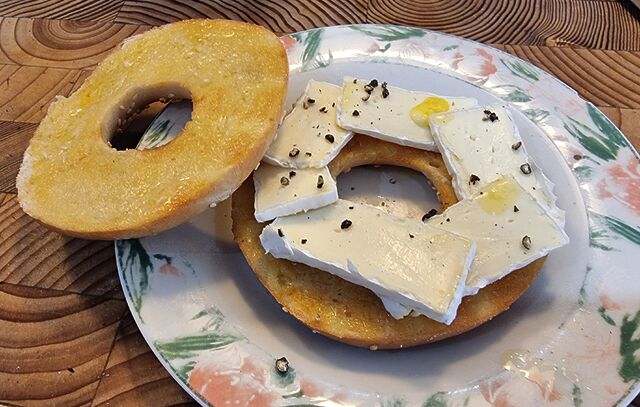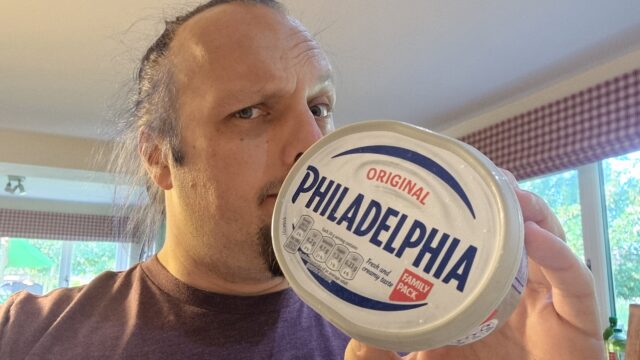Maybe I’m just hungry, but this morning’s breakfast bagel with brie looks especially scrumptious, right?
Tag: cheese
Philadelphia
Shower thought for the morning was: why is cream cheese spread ‘Philadelphia’ called that? Is it from Philadelphia? (My box isn’t, of course: it came from Ireland.)
Nope, it turns out that it was originally invented in New York in the 19th century and named for Philadelphia because Philadelphia, PA was at that point famous for its dairy industry. Just another bit of parasitic branding leveraging a borrowed association, like the Quaker Oats guy or the Rolls Razor. Now I’m wondering how many other examples I can find!
Stolen from Costa
Say… “Cheese?”
For lunch today I taste-tested five different plant-based vegan “cheeses” from Honestly Tasty. Let’s see if they’re any good.
Prefer video?
This blog post is available as a video (here or on YouTube), for those who like that sort of thing. The content’s slightly different, but you do get to see my face when I eat the one that doesn’t agree with me.
Background
I’ve been vegetarian or mostly-vegetarian to some degree or another for a little over ten years (for those who have trouble keeping up: I currently eat meat only on weekends, and not including beef or lamb), principally for the environmental benefits of a reduced-meat lifestyle. But if I’m really committed to reducing the environmental impact of my diet, the next “big” thing I still consume is dairy products.
My milk consumption is very low nowadays, but – like many people who might aspire towards dropping dairy – it’s quitting cheese that poses the biggest challenge. I’m not even the biggest fan of cheese, and I don’t know how I’d do without it: there’s just, it seems, no satisfactory substitute.
It’s possible, though, that my thinking on this is outdated. Especially in recent years, we’re getting better and better at making convincing (or, at least, tasty!) plant-based substitutes to animal based foods. And so, inspired by a conversation with some friends, I thought I’d try a handful of new-generation plant-based cheeses and see how I got on. I ordered a variety pack from Honestly Tasty (who’ll give you 20% off your first order if you subscribe your favourite throwaway email address to their newsletter) and gave it a go.
Bree
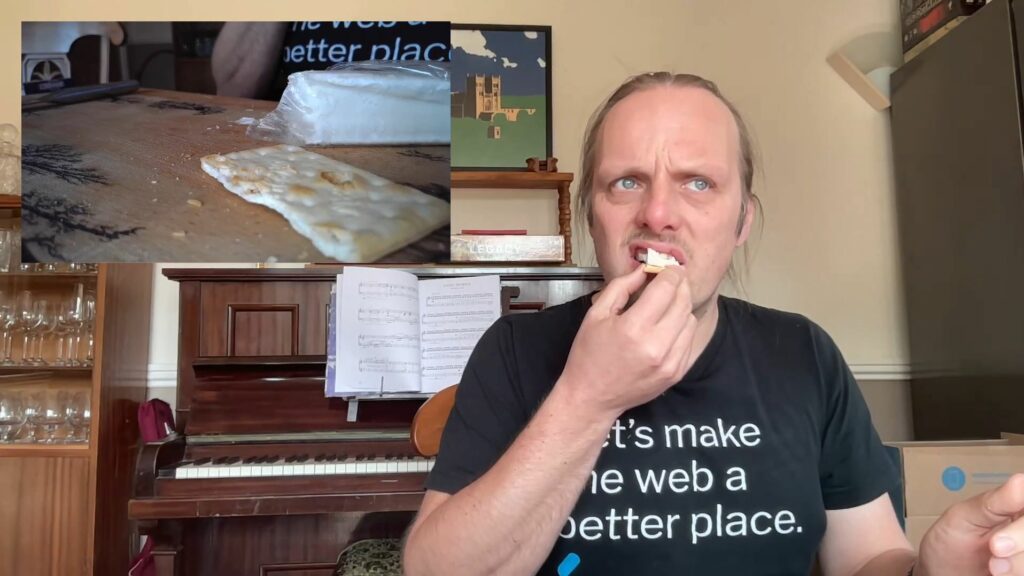
It’s supposed to taste like Brie, I guess, but it’s not convincing. The texture of the rind is surprisingly good, but the inside is somewhat homogeneous and flat. They’ve tried to use
mustard powder to provide Brie’s pepperiness and acetic acid for its subtle sourness, but it feels like there might be too much of the former (or perhaps I’m just a little oversensitive
to mustard) and too little of the latter. It’s okay, but I wouldn’t buy it again.
Ched Spread

This was surprisingly flavoursome and really quite enjoyable. It spreads with about the consistency of pâté and has a sharp tang that really stands out. You wouldn’t mistake it for
cheese, but you might mistake it for a cheese spread: there’s a real “cheddary” flavour buried in there.
Blue

This is supposed to be modelled after Gorgonzola, and it might as well be because I don’t like either it or the cheese it’s based on. I might loathe Blue slightly less than
most blue cheeses, but that doesn’t mean I’d willingly subject myself to this again in a hurry. It’s matured with real Penicillium Roqueforti, apparently, along with seaweed, and it
tastes like both of these things are true. So yeah: I hated this one, but you shouldn’t take that as a condemnation of its quality as a cheese substitute because I’d still rather eat it
than the cheese that it’s based on. Try for yourself, I guess.
Herbi
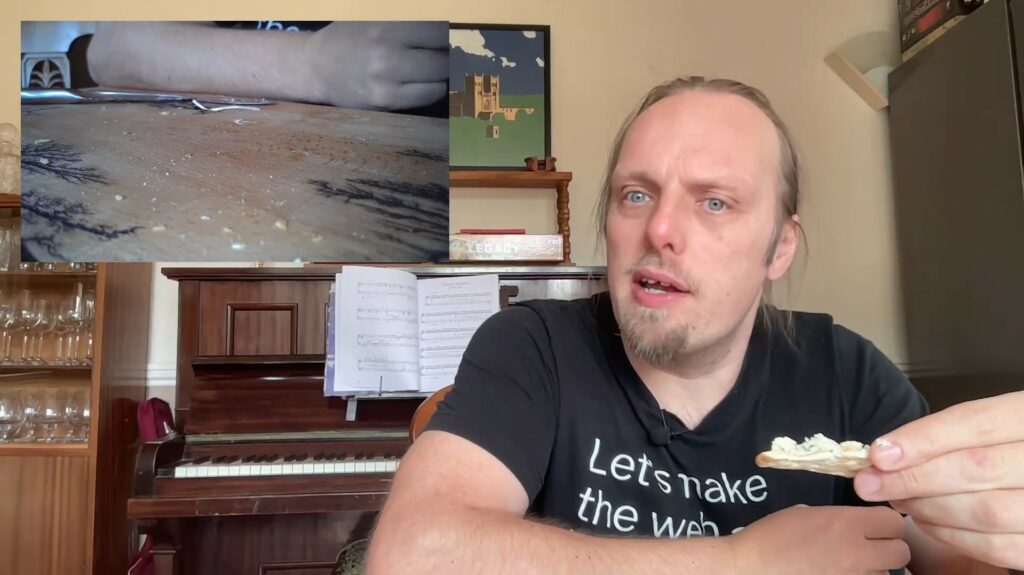
This was probably my favourite of the bunch. It’s reminiscent of garlic & herb Boursin, and feels like somebody in the
kitchen where they cooked it up said to themselves, “how about we do the Ched Spread, but with less onion and a whole load of herbs mixed-through”. It seems that it must be easier to
make convincingly-cheesy soft cheeses than hard cheeses, but I’m not complaining: this would be great on toast.
Shamembert
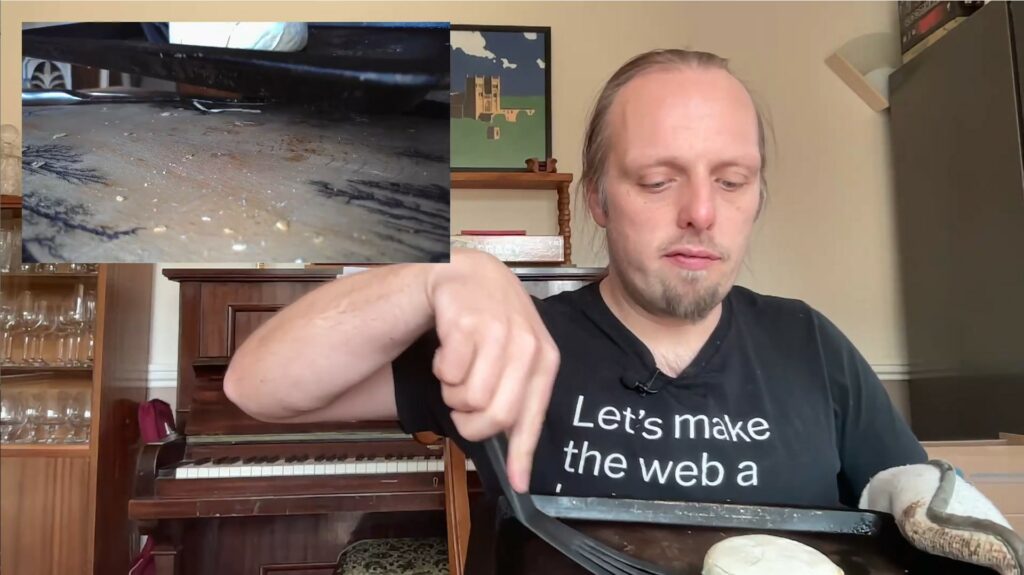
If you’d served me this and told me it was a baked Camembert… I wouldn’t be fooled. But I wouldn’t be disappointed either. It moves a lot like Camembert and it tastes… somewhat like it.
But whether or not that’s “enough” for you, it’s perfectly delicious and I’d be more than happy to eat it or serve it to others.
In summary…
Honestly Tasty’s Ched Spread, Herbi, and Shamembert are perfectly acceptable (vegan!) substitutes for cheese. Even where they don’t accurately reflect the cheese they attempt to model, they’re still pretty good if you take them on their own merits: instead of comparing them to their counterparts, consider each as if it were a cheese spread or soft cheese in its own right and enjoy accordingly. I’d buy them again.
Their Bree failed to capture the essence of a good ripe Brie and its flavour profile wasn’t for me something to enjoy outside of its attempts at emulation. And their “Veganzola” Blue cheese… was pretty grim, but then that’s what I think of Gorgonzola too, so maybe it’s perfect and I just haven’t the palate for it.
You know what they call a MegaLounge in France?
This self-post was originally posted to /r/MegaLoungeFrance. See more things from Dan's Reddit account.
A Royale Lounge with Cheese.
Here! Have some cheese. Cheese! CHEESE! CHEESE FOR EVERYBODY!!!
I might not be getting enough sleep.
How to make a Cheese & Pickle Sandwich
The entire infrastructure of our civilization – our entire species – is something that you can’t help but take for granted. Let’s make a cheese & pickle sandwich.
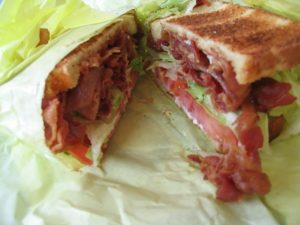
How to make a Cheese & Pickle Sandwich
Find a grass whose seed, when crushed, yields a powdery flour rich in carbohydrates and proteins – any of the dozens of species of wheat will do, but there are plenty others besides. If you’re genuinely starting from scratch, you might find that it’s first worth your while cultivating and selectively breeding the cereal to improve its yield. Separate off the dry outer chaff from the seeds and grind them. You’ll also need some yeast, which you can acquire from the environment by letting water in which you’ve boiled vegetables sit in the warm for a few days, or by extracting it from the skins of fruits: alternatively, you can make use of yeast spores in the atmosphere by working slowly in the vicinity of fermenting sugars; e.g. somebody brewing alcohol. Combine the flour with some water and the yeast to make a dough, let it rise, then put it in a hot box for a while to bake it. There’s your bread.
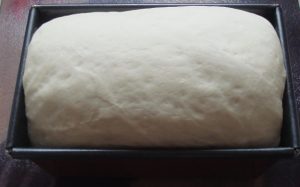
Meanwhile, domesticate some cattle. You’ll need to have started this quite a while earlier. Specifically, you’re going to need cows that have recently weaned a calf, so they’re still lactating. Manipulate the teats of the cow to extract its milk, then heat it gently while stirring it. Assuming that you don’t have the resources to identify and separate lactococcus bacteria, you’ll want to be careful not to heat the milk enough that it kills any such bacteria already in it. Add an edible acid (lemon juice will do, assuming you’ve got access to lemons; alternatively you could use vinegar, which you’ll be needing later on anyway) to cause the milk to begin separating into curds (the solid part) and whey (the liquid part) – alternatively, if you’ve got spare unweaned calves that you can kill and harvest the stomachs of, you can use rennet. If you’ve got the hang of processing cotton, you can weave yourself a square of cheesecloth and use this as a filter. Once you’ve reduced the curds as far as possible, wrap it and squeeze it in a press (you can make this by putting weight on it) for a few days, turning occasionally. Then, cover it in an airtight seal of wax (you can get this by melting honeycombs taken from a beehive), and leave it for a month or two. There’s your cheese.

Harvest some fruit and vegetables, such as – depending on availability – swede, carrots, dates, onions, cauliflower, apples, courgettes, and tomatoes, and dice them. Boil together in vinegar with cloves, mustard, and sugar added until the hardest parts (typically the swede) are firm but not crunchy. Heat a sterile, airtight container, add the mixture, and seal. Leave for a couple of weeks. Oh: you don’t have vinegar? No problem: first you’re going to need alcohol, which you can produce from fruit – apples are probably easiest; grapes are another popular choice – and yeast: just combine the two and give it a few weeks. Now, to turn that into vinegar, keep it at just over room temperature for several more weeks, stirring regularly to aerate it. Seriously: if you thought that learning to milk a cow was hard, you should have given up long before now. Anyway: there’s your pickle.
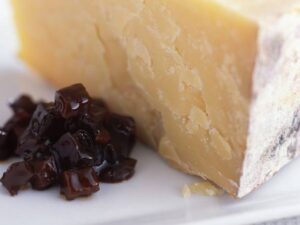
You’ll also want some butter, but by this point you’re used to a little work. Assuming you don’t have access to a centrifuge, the traditional thing to do next is to leave it sitting in a shallow pan for about 24 hours, then skimming off the top – congratulations, you’ve got cream (the remaining milk is now what you would call skimmed milk; I suggest you have yourself a cool glass of it while you start working on the next bit). Put the cream into a bowl with a pinch of salt and work it, keeping it as cool as possible while you do so, as if you were trying to make whipped cream… but keep going! If you whip it for long enough it’ll gradually become more and more solid: drain it of the excess liquid (this is buttermilk), and then form it into a ball or block. Hurrah: you’ve got butter!

Finally, you can assemble your sandwich. Slide the bread, spread butter onto the slices, and put slices of the cheese and a spoonful of pickle in between them. That wasn’t so hard, now, was it?
Why, Dan, why?
You’ll be forgiven if you’re wondering why I’ve just shared with you the most drawn-out recipe imaginable, for something so simple as a cheese & pickle sandwich.
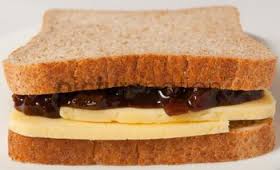
It’s just this: think about how much was involved in that process (and I didn’t even talk about making the tools you’d need). How complex is that process, compared to everything eaten by every other animal on the planet. Otters use rocks to get into shellfish, and chimpanzees use sticks to pull termites out of nests, but apart from these – and a few other exceptions – virtually no other species we’ve ever come across does anything more than picking or hunting for their food, and then eating it. We, on the other hand – even for our simplest processed foods – put a monumental amount of effort into making them the way they are.
And as if that weren’t complex enough, we go even further. We make different kinds of bread and cheese with different kinds of flour and milk, different processes, different ages; we make different brands of pickle and butter, and then argue on the Internet about which one is the best. We make sandwiches with egg mayonnaise (boiled eggs… in an emulsion of egg yolks and oil), with roasted or cured meats of different kinds of animals, with hummus (a remarkably complicated ingredient in its own right).
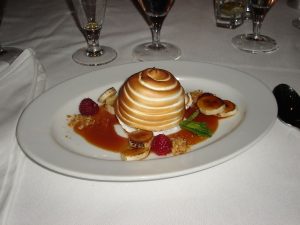
When you make yourself a sandwich, you’re standing upon the shoulders of the hundreds of generations that preceded you, and all of their peers. A collective knowledge passed down over millennia. In reality, nobody milks a cow because they want to make a sandwich: but that separation is only possible because of the enormous infrastructure we’ve built up in order to support the production and distribution of dairy goods.
We are, indeed, a very strange species.
But if you actually do have a go at making a sandwich based on this recipe, let me know how you get on.
TIL that the “holes” in Swiss cheese were, until recently, seen as a sign of imperfection and something cheesemakers tried to avoid
This link was originally posted to /r/todayilearned. See more things from Dan's Reddit account.
The original link was: https://en.wikipedia.org/wiki/Emmental_cheese
…
Three types of bacteria are used in the production of Emmental: Streptococcus thermophilus, Lactobacillus helveticus, and Propionibacterium freudenreichii. Historically, the holes were a sign of imperfection, and until modern times, cheese makers would try to avoid them. Emmental cheese is used in a variety of dishes, particularly in gratins, and fondue, where it is mixed with Gruyère.
…
Wikipedia
Edinburgh 2012 – Day Two
Our second day at the Edinburgh Fringe brought new opportunities for fun and merriment. Once we finally dragged ourselves from our beds.

First up, we insisted that Matt joined us in watching the show of Young & Strange, a talented pair of magicians we first saw earlier this year, at the Oxford Fringe. Their act wasn’t quite so magical on a second viewing, and some of their tricks wear thin on the closer-inspection made possible by the tiny venue and the orientation of the lights, but they’re still remarkable showmen and real masters of their craft. Matt was invited on stage to assist with a trick involving separating all of the different denominations of currency into twelve numbered envelopes (1p, 2p, 5p, 10p, 20p, 50p, £1, £2, £5, £10, £20, £50). I tell you this because it’ll be relevant in a subsequent blog post. Seriously.

Later, we watched the incredibly disappointing Computer Programmer Extraordinaire, by comedian Raph Shirley. For all of his good ideas (and he certainly had enough of them to fill a 15 minute set, but 45 minutes seemed like far too long), his delivery was sorely lacking. Maybe we went in expecting something that we wouldn’t get – his “geeky” computer programmer persona didn’t really cut it for those of us who were genuine geeky computer programmers in the audience – but even if we put that aside, there weren’t enough laughs in the show to have been worth the time it took to “get there”, even at no cost.

Ruth, JTA and I then disappeared off to Whiski Rooms for a “Whisky & Cheese Tasting” event. This was really quite enjoyable, and I was surprised to be able to, under a little guidance (and with the inclination to pay particular attention to the subtler facets of what I was drinking), find entirely new flavours even in whiskies with which I was already familiar. Pairing whiskies with cheeses was also a new experience for me, and – even for somebody like me, who enjoys cheese in moderation but doesn’t have the palate for the full spectrum of cheeses – provided some fascinating opportunities to find new flavours.*
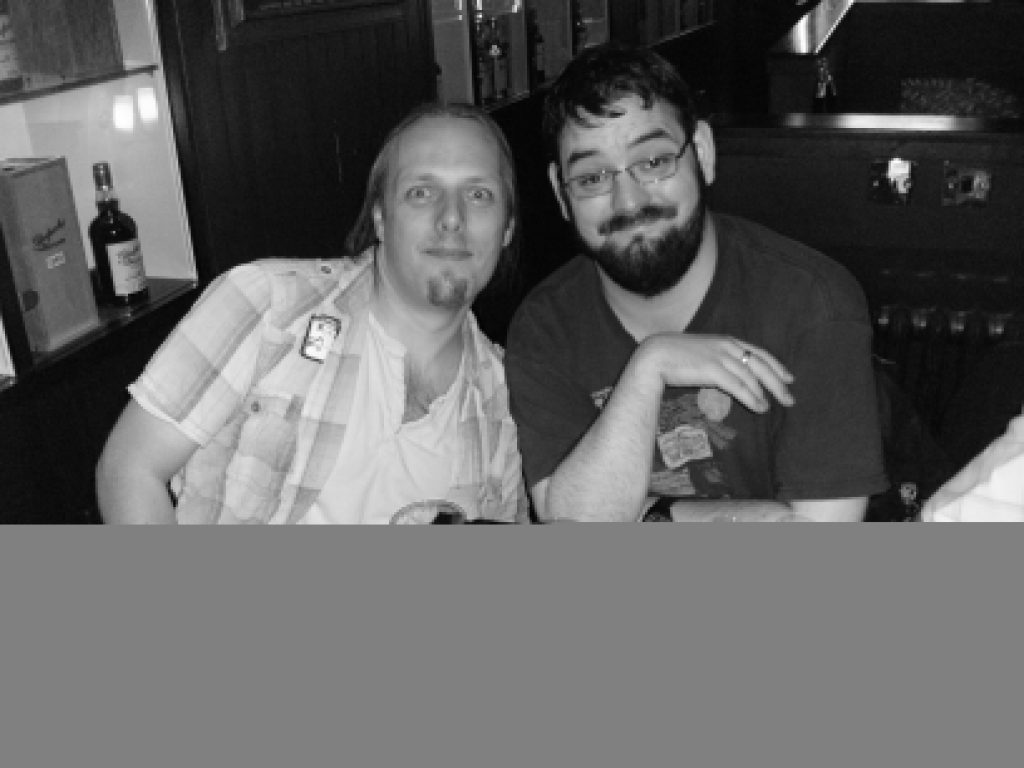
This – coupled with the drinks we’d already had and those we had later – left us rather tipsy. Although thankfully still nowhere near as drunk as Claire was, here in Edinburgh, when six years ago she did the most embarrassing thing in the world.

Finally, we reconvened with Matt for a dose of Peter Buckley Hill And Some Comedians. I don’t remember his name, but I was particularly impressed with the dry, deadpan delivery of the dutch comedian. If it comes back to me, I’ll come back and write his name in here: ____________________. Look, I’ve left a nice long gap and everything.
* For anybody who’s interested, the whiskies we tried (and the cheeses they were paired with) were: Tobermory 10 with Keens Cheddar; Jura Superstition with Old Smokey; Bruichladdich 10 with Adrahan; and Bowmore 12 with Dunsyre Blue.
Almost Passed This On The Way To Work
Another fantastic story from the BBC: this one took place yesterday, and so I missed it, as I didn’t come in to work. Apparently this lorry full of cheese caught fire on the A44, on my usual route to the office. The driver said: “I saw the fire starting but by the time I’d gone back to the cab to get the fire extinguisher the whole lot had started to go on fire.”
1. Cheese burns?
2. What route did he take back to the cab? Via Bow Street?
3. How does combusion occur in the hold of a moving lorry full of milk produce?
